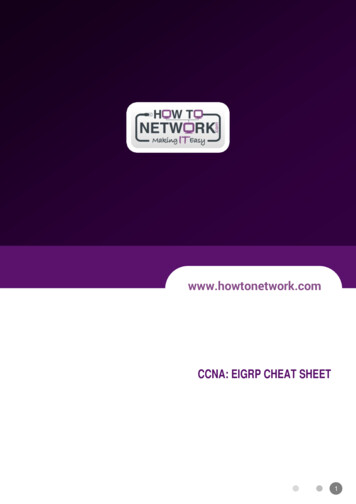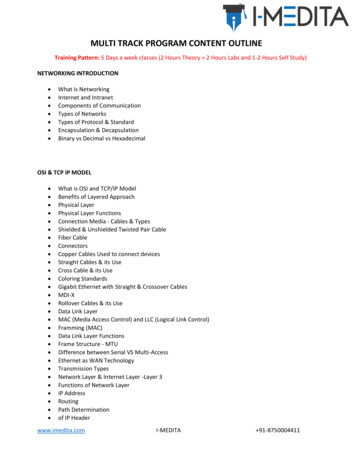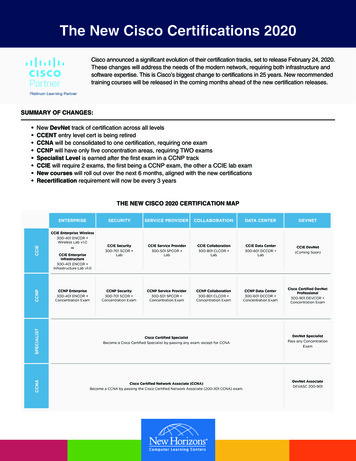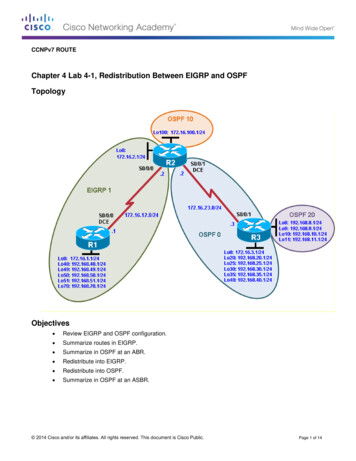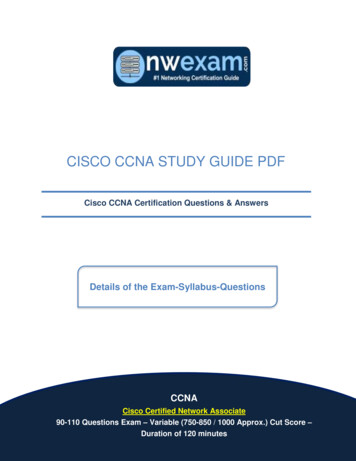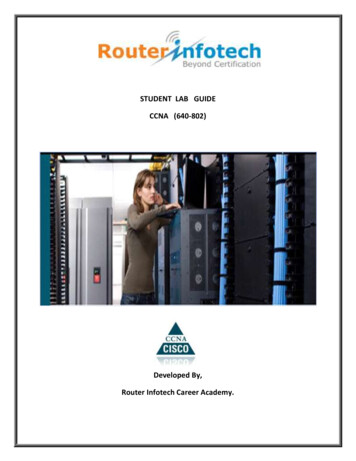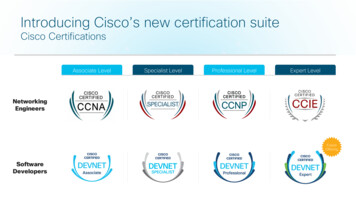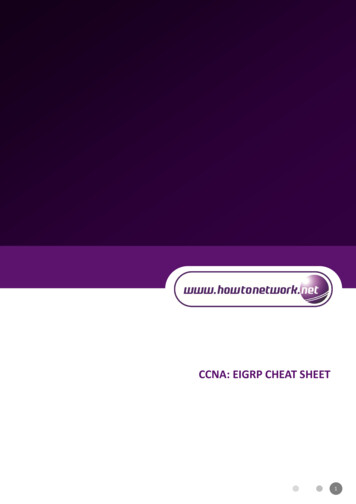
Transcription
CCNA: EIGRP CHEAT SHEET1
CCNA: EIGRP CHEAT SHEETKey CharacteristicsRouter ID (RID)Type: Advance Distance Vector or HybridAlgorithm: Diffusing Update Algorithm (DUAL)Standard: Cisco ProprietyAdministrative Distance:RID should be a valid IP address, not a 32-bit dotteddecimal numberCisco Routers uses the following criteria to select arouter ID:1. Internal Routes 902. External Routes 1703. Summary Routes 5Metric: CompositeTransport Protocol/Protocol Number: IP/88Routed Protocol Support: IP, IPX and AppleTalkAuthentication: Yes (MD5 only)Supports VLSM and Route Summarization: YesFastest ConvergenceMetric CalculationEIGRP uses a composite metric. Composite metricconsists of bandwidth, load, delay, reliability and MTUBy default, only bandwidth and delay are consideredMetric 256 x [(10 7/minimum-bandwidth) cumulative delay]Bandwidth is in kbps and delay is in micro-secondsMinimum bandwidth represents least bandwidth alongthe entire routeCumulative Delay represents the sum of all delayvalues for all links in the routeNeighbor DiscoveryEIGRP sends hellos on multicast address 224.0.0.10 todiscover potential neighbors. Hellos are always use unreliable deliveryTo become neighbors EIGRP routers must be agree onthe following parameters:1.2.3.4.Autonomous System (AS) numberSame primary subnetAuthentication (if used)K-values must match1. RID configured with “router-id” command2. If manual RID not configured, select the highestnumber IP address on any loopback interface in“up/up” state3. If loopback interfaces not configured, select thehighest number IP address on any non-loopbackinterface in “up/up” stateRoute Types and PreferenceInternal Routes: routes advertised within the same ASExternal Routes: routes imported from another routingdomain or ASInternal Routes are denoted with “D”External Routes are denoted with “EX”Routes Preference:1. Internal Routes (90) External Routes (170)EIGRP Table TypesEIGRP maintains three types of tables:1. Neighbor Table: keeps state information regardingneighbors, and is displayed using the “show ip eigrpneighbors” command2. Topology Table: EIGRP Update messages fill therouters’ EIGRP topology tables. Topology table can bedisplayed with “show ip eigrp topology” command3. (IP) Routing Table: Based on the contents of thetopology table, each router chooses its best routes andinstalls these routes in its respective IP routing table.The IP routing table is displayed with “show ip route”commandPacket TypesHello: used in neighbor discovery/recovery process, are always multicast and use unreliable delivery (noacknowledgement is required)Acknowledgment: are hello packets without any data and are always unicast & use unreliable deliveryUpdate: Convey route information. Updates are non-periodic, partial, bounded, can be unicast or multicast and usereliable deliveryQuery and Reply: used by DUAL finite state machine. Queries can be unicast or multicast and replies are alwaysunicast, using RTP.Topology ExchangeEIGRP exchanges topology updates on multicast address 224.0.0.10 using Reliable Transport Protocol (RTP)If an acknowledgment is not received for the multicast update, the update is then re-transmitted as unicast to theun-responsive neighbor. After 16 unicast re-transmission, the neighbor is declared deadEIGRP updates are:1. Non-Periodic: updates are sent only when some topological or metric change has occurred2. Partial: only relevant changes are advertised3. Bounded: updates are sent to affecting neighbors2
CCNA: EIGRP CHEAT SHEETTimersHello Time: 5 seconds for link faster than T1 and 60 seconds for T1 and slower linksHold Time: 3 times the hello. 15 seconds for links faster than T1 and 180 seconds for T1 and slower linksSmooth Round Trip Time (SRTT): the average time elapsed (in milliseconds) between the transmission of packet toneighbor and the receipt of acknowledgeRetransmission Timeout (RTO): time between subsequent unicast messages. It is the time that router will wait for anacknowledgement after sending unicast packet sent after a multicast has failedDUAL Terms and Route SelectionAdjacency: logical session between two neighbors over which route information is exchangedReported Distance (RD): is the distance (metric) towards a destination as advertised by an upstream neighbor.Feasible Distance (FD): Lowest calculated distance (metric) to the destination from local router’s perspective.Some books/texts use Advertised Distance instead of Reported Distance.Successor: A particular route with the best metric is a successor. It may also refer to a router that is being used asthe next-hop for that particular route. With two or more successors (routes) if FDs are the same, load balancinghappens automaticallyFeasible Successor (FS): Backup router with loop-free path for a particular route. FS is a neighbor who’s Reported orAdvertised Distance (AD/RD) is less than the current Feasible Distance (FD) for that particular route. FeasibleSuccessor is one who meets the feasible conditionFeasible Condition (FC): RD of a particular route from a neighbor which is not the current successor for that routemust be less than the FD for that particular route. The logic is simple: if a neighbors metric for a route is less thanmine, then I know the neighbor doesn't have a loop going through meEqual and Unequal Cost Load BalancingEIGRP support equal and unequal cost load balancingEqual cost load balancing is enabled by default. Routes with equal feasible distance are installed by default in therouting tableVariance is used to achieve unequal cost load balancing. Default value for variance is: 1, which will cause the EIGRPto select the best/lowest cost path onlyVariance defines the multiplier by which a metric may differ from the lowest cost route. By default 4-paths areallowed but can be extended to 16-paths with “maximum-paths path ” commandVariance is given by: higher cost metric / lower cost metricRule for Variance:1. Load balance path should lead to successor or feasible successor (that is if it met the Feasibility Condition)Configuration Example: network statement and authentication3
CCNA: EIGRP CHEAT SHEETConfiguration Example: network statement and authenticationRouter R1:key chain EIGRP KCkey 1key-string cisco!interface loopback 0ip address 10.1.1.1 255.255.255.255!interface serial 0/0ip address 192.168.12.1 255.255.255.252ip authentication eigrp 100 md5ip authentication key-chain eigrp 100 EIGRP KC!router eigrp 100no auto-summarynetwork 192.168.12.0network 10.1.1.0Router R2:key chain EIGRP KCkey 1key-string cisco!interface loopback 0ip address 10.2.2.2 255.255.255.255!interface serial 0/0ip address 192.168.12.2 255.255.255.252ip authentication eigrp 100 md5ip authentication key-chain eigrp 100 EIGRP KC!router eigrp 100no auto-summarynetwork 192.168.12.0network 10.2.2.0R1#sh ip route b GatewayGateway of last resort is not set192.168.12.0/30 is subnetted, 1 subnets192.168.12.0 is directly connected, Serial0/010.0.0.0/32 is subnetted, 2 subnetsD10.2.2.2 [90/2297856] via 192.168.12.2, 00:00:14, Serial0/0C10.1.1.1 is directly connected, Loopback0CConfiguration Example: variance and unequal cost load balancingRouter R1:interface loopback 0ip address 10.1.1.1 255.255.255.255!interface serial 0/0ip address 192.168.12.1 255.255.255.252!interface fastethernet0/0ip address 192.168.21.1 255.255.255.252!router eigrp 100variance 15network 10.1.1.0network 192.168.12.0network 192.168.21.0no auto-summaryRouter R2:interface loopback 0ip address 10.2.2.2 255.255.255.255!interface serial 0/0ip address 192.168.12.2 255.255.255.252!interface fastethernet0/0ip address 192.168.21.2 255.255.255.252!router eigrp 100variance 15network 10.2.2.0network 192.168.12.0network 192.168.21.0no auto-summaryR1#sh ip route eigrp10.0.0.0/32 is subnetted, 2 subnetsD10.2.2.2 [90/156160] via 192.168.21.2, 00:03:21, FastEthernet0/0[90/2297856] via 192.168.12.2, 00:03:21, Serial0/0R2#sh ip route eigrp10.0.0.0/32 is subnetted, 2 subnetsD10.1.1.1 [90/156160] via 192.168.21.1, 00:03:06, FastEthernet0/0[90/2297856] via 192.168.12.1, 00:03:06, Serial0/04
CCNA: EIGRP CHEAT SHEETTroubleshooting Command1.2.3.4.5.6.7.show ip protocolsshow ip eigrp neighborsshow ip eigrp interfacesshow ip eigrp topologyshow ip routedebug eigrp packets [hello ack query reply update]debug eigrp fsm5
CCNA: EIGRP CHEAT SHEET Troubleshooting Command 1. showipprotocols 2. showipeigrpneighbors 3. showipeigrpinterfaces 4. showipeigrptopology 5. showiproute 6. debugeigrppackets[hello ack query reply update] 7. debugeigrpfsm 5. Title Microsoft PowerPoint - CCNA_EIGRP_Cheat_Sheet_Updated
